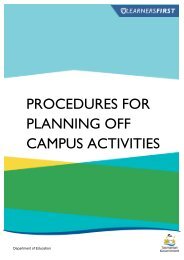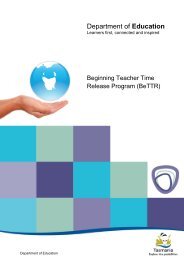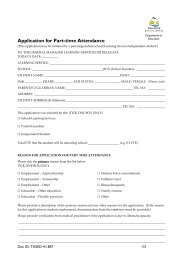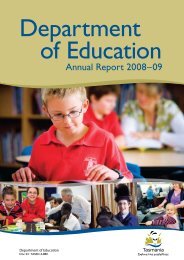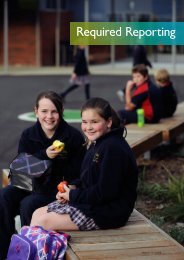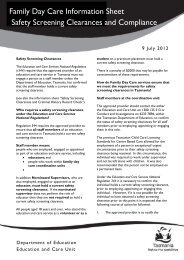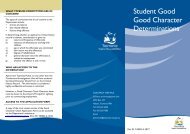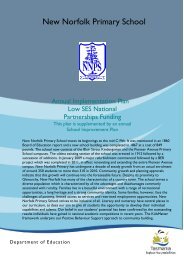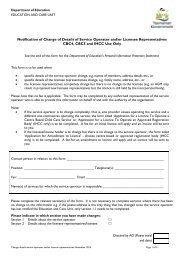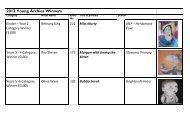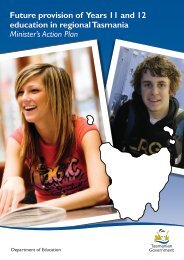Education
DoE Annual Report 2012-2013 - Department of Education
DoE Annual Report 2012-2013 - Department of Education
- No tags were found...
Create successful ePaper yourself
Turn your PDF publications into a flip-book with our unique Google optimized e-Paper software.
Major Initiatives<br />
Implementation<br />
of the<br />
Recommendations<br />
of the<br />
Review into<br />
the Role and<br />
Function of<br />
Tasmania’s<br />
Public VET<br />
Providers<br />
An independent review of the role and function of<br />
Tasmania’s public VET providers was completed during<br />
the 2011–12 financial year. The implementation of the<br />
recommendations from the review formed a significant<br />
part of the division’s work during the 2012–13 financial year.<br />
The review made 60 recommendations, the<br />
overwhelming majority of which were accepted. All of<br />
the recommendations that related to the establishment<br />
of a single entity for the delivery of publicly funded VET in<br />
Tasmania have been actioned. The new entity, TasTAFE,<br />
commenced on 1 July 2013.<br />
The process undertaken to establish TasTAFE was<br />
overseen by a high level steering committee and managed<br />
by a specifically established project management team.<br />
It was actioned by a large number of working groups,<br />
each established to achieve specific outcomes relative<br />
to individual components of the new TasTAFE structure.<br />
A feature of these working groups was that they involved,<br />
in total, the active participation of over 150 staff<br />
members from the Tasmanian Polytechnic and<br />
Tasmanian Skills Institute.<br />
The process also involved the successful development<br />
and implementation of the legislative framework<br />
necessary to facilitate the establishment of the appropriate<br />
governance framework within which the new organisation<br />
would function. This objective was achieved with the<br />
passage of the relevant legislation, the Training and<br />
Workforce Development Bill 2013, the Training and Workforce<br />
Development (Transitional Provisions) Bill 2013 and the Training<br />
and Workforce Development (Repeals and Consequential<br />
Amendments) Bill 2013 through the Tasmanian Parliament<br />
in May 2013.<br />
Retention and<br />
Attainment<br />
Strategy<br />
The Retention and Attainment Strategy Years 10–12 guides<br />
the work of the Department of <strong>Education</strong> in improving<br />
the transition of students from Year 10 to further<br />
education and training, engaging students so they gain a<br />
meaningful Year 12 or equivalent qualification.<br />
A key initiative of the strategy is the introduction of<br />
a tracking system for students from Year 10 to the<br />
completion of Year 12 or equivalent. This is incorporated<br />
in 2013 into the Student Support System (SSS). As a<br />
result of this data collection, there is an extensive process<br />
of following up at-risk and disengaged students and<br />
supporting their re-engagement. This year saw the further<br />
refinement of the support model with the appointment of<br />
four Youth Transition Officers (YTOs).<br />
The student tracking system involves all colleges and<br />
the Tasmanian Polytechnic following up on Year 11 and<br />
12 leavers. The YTOs from Guaranteeing Futures teams<br />
are integral to this process. Reports on progress are<br />
submitted on 1 May, 1 September and 30 November.<br />
The strategy focuses on a range of areas to support<br />
transition, engagement and achievement of qualifications<br />
including:<br />
• high quality pathway planning<br />
• open and consistent communication between schools,<br />
colleges, the Tasmanian Polytechnic and (more<br />
recently) TasTAFE<br />
• a coordinated approach to course offerings<br />
• quality information available to and accessible by<br />
students, parents and teachers<br />
• quality teaching<br />
• quality learning support and learning environments<br />
• relevant and flexible programs.<br />
In line with the strategy, a focal point for the Guaranteeing<br />
Futures teams is to work with all Year 10 students to<br />
ensure they are well informed about choices for their<br />
future options. This encompasses supported transition<br />
processes including:<br />
• the ‘2014 Your Guide to <strong>Education</strong> and Training in Years<br />
11 and 12’; a statewide guide outlining programs and<br />
courses available in different regions across the state<br />
• suitability processes for VET programs to ensure<br />
students are in appropriate learning options<br />
• enrolments into Year 11 courses informed by a<br />
student’s transition profile.<br />
As noted earlier, Tasmania’s target is for 81.6% of students<br />
to attain Year 12 or equivalent qualifications by 2015.<br />
Tasmania’s most recently measured attainment rate is<br />
78.35%¹.<br />
1. COAG Reform Council’s report on the assessment of the National<br />
Partnership Agreement on Youth Attainment and Transitions attainment<br />
targets (August 2013).<br />
Student<br />
Retention<br />
Beyond the<br />
Compulsory<br />
Years in Rural,<br />
Regional and<br />
Disadvantaged<br />
Communities<br />
Project<br />
The Australian Research Council (ARC) Linkage Project is<br />
a collaborative longitudinal study being undertaken by the<br />
University of Tasmania and the Department of <strong>Education</strong>,<br />
which commenced in July 2011.<br />
The project is investigating the nature, impact and efficacy<br />
of a range of intervention strategies at primary school,<br />
secondary school and college levels aimed at enhancing<br />
student retention in education beyond the compulsory<br />
years of schooling. It will build knowledge of the ways in<br />
which factors known to influence retention interact with<br />
one another and other relevant but under-researched<br />
variables. This three year study will be located in rural,<br />
regional and lower socioeconomic areas of Tasmania.<br />
Post-Compulsory <strong>Education</strong> and Skills Development<br />
43



